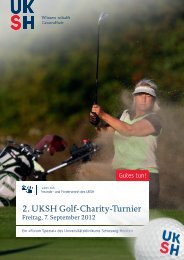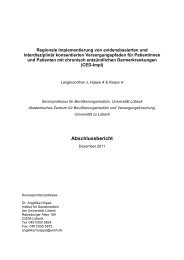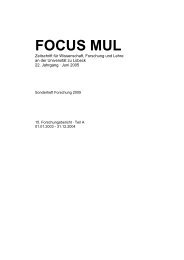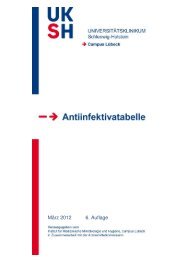Empfehlungen zur kalkulierten parenteralen Initialtherapie ...
Empfehlungen zur kalkulierten parenteralen Initialtherapie ...
Empfehlungen zur kalkulierten parenteralen Initialtherapie ...
Sie wollen auch ein ePaper? Erhöhen Sie die Reichweite Ihrer Titel.
YUMPU macht aus Druck-PDFs automatisch weboptimierte ePaper, die Google liebt.
<strong>Empfehlungen</strong> <strong>zur</strong> <strong>kalkulierten</strong> <strong>parenteralen</strong> <strong>Initialtherapie</strong> bakterieller Erkrankungen bei Erwachsenen – Update 2010<br />
alter dominieren Monoinfektionen durch<br />
S. aureus, Streptokokken, Serratia marcescens<br />
oder Proteus spp. Die kalkulierte<br />
Therapie wird mit einem Cephalosporin<br />
der Gruppe 2 in Kombination mit Clindamycin<br />
oder einem Aminopenicillin/BLI<br />
begonnen. Alternativ kann ein Fluorchinolon<br />
der Gruppe 2 oder 3 in Kombination<br />
mit Clindamycin oder Moxifloxacin<br />
als Monotherapie eingesetzt werden. Bei<br />
komplizierten Fällen (z. B. schwere Spondylodiscitis)<br />
kann die Kombination von Fosfomycn<br />
mit einem Cephalosporin erwogen<br />
werden [29]. Sobald ein Erregernachweis<br />
und eine Empfindlichkeitsprüfung vorliegen,<br />
sollte die Umstellung auf eine gezielte<br />
Therapie erfolgen.<br />
Posttraumatische/<br />
postoperative Ostitis<br />
Eine Infektion aller Elemente des Knochenbaus<br />
ist als Ostitis definiert. Diese entsteht<br />
in der Regel posttraumatisch/postoperativ<br />
durch direkte Kontamination während<br />
eines Traumas bzw. intraoperativ. Häufig<br />
liegen Mischinfektionen mit Staphylokokken,<br />
Streptokokken, Enterobacteriaceae<br />
und Anaerobiern vor. Bei der postoperativen<br />
Ostitis dominieren Staphylokokken.<br />
Die Therapie muss möglichst frühzeitig in<br />
einem chirurgischen Débridement, einer<br />
Stabilisierung des Knochens und einer initial<br />
<strong>kalkulierten</strong> Antibiotika-Behandlung<br />
bestehen. Empfohlen werden ein Aminopenicillin/BLI,<br />
ein Cephalosporin der<br />
Gruppe 2 und Clindamycin. Bei hohem<br />
Risiko für multiresistente Staphylokokken<br />
kann Daptomycin, Linezolid oder Teicoplanin<br />
oder eine Kombination mit Fosfomycin<br />
eingesetzt werden. Rifampicin zeigt<br />
eine gute Penetration in den Biofilm. Bei<br />
der chronischen Ostitis muss der infizierte<br />
Knochen entfernt werden. Hier sollte eine<br />
gezielte Antibiotika-Therapie erfolgen [13,<br />
16].<br />
Sternumostitis<br />
Die Sternumostitis wird im Wesentlichen<br />
durch S. aureus und Koagulase-negative<br />
Staphylokokken – nicht selten multiresistent<br />
– verursacht. Die Antibiotika-Therapie<br />
erfolgt initial hochdosiert mit einem<br />
Isoxazolylpenicillin oder einem Cephalosporin<br />
der Gruppe 2 in Kombination mit<br />
Clindamycin oder Fosfomycin. Bei MRSA<br />
oder Methicillin-resistenten Koagulasenegativen<br />
Staphylokokken, wie z. B. Staphylococcus<br />
epidermidis, wird der Einsatz<br />
von Daptomycin oder Linezolid empfohlen<br />
[30].<br />
Bakterielle Arthritis<br />
Wesentliche Ursache der bakteriellen Arthritis<br />
ist die iatrogene Infektion. Dabei ist<br />
hinsichtlich der Prognose die Frühinfektion<br />
von der Spätinfektion zu differenzieren.<br />
Beim Erregerspektrum handelt es<br />
sich meist um Staphylokokken oder betahämolysierende<br />
Streptokokken der Gruppen<br />
A, B, C oder G. Andere Erreger wie<br />
Enterobacteriaceae und Gonokokken sind<br />
selten. Neben der chirurgischen Therapie<br />
wird die gleiche kalkulierte Antibiotika-<strong>Initialtherapie</strong><br />
wie bei der Ostitis empfohlen.<br />
Bei den seltenen Infektionen durch Salmonellen<br />
oder Gonokokken ist die alleinige<br />
Antibiotika-Therapie ausreichend.<br />
Prothesen-Infektionen<br />
Infizierte Prothesen sollten möglichst<br />
durch den Ausbau bzw. Wechsel nach<br />
großzügigem chirurgischem Débridement<br />
und einer Antibiotika-Therapie in maximaler<br />
Dosierung saniert werden [27]. Nur bei<br />
lebensbedrohlichen Kontraindikationen ist<br />
vom operativen Prothesenwechsel ab<strong>zur</strong>aten.<br />
Heilungen unter konservativer Therapie<br />
sind sehr selten.<br />
Literatur<br />
1. Arbeit RD, Maki D, Tally FP, Campanaro<br />
E, et al. The safety and efficacy of daptomycin<br />
for the treatment of complicated<br />
skin and skin-structure infections.<br />
Clin Inf Dis 2004;38:1673-81.<br />
2. Barie PS, Eachempati SP. Surgical<br />
site infections. Surg Clin North Am<br />
2005;85:1115-35.<br />
3. Berendt AR, Peters EJ, Bakker K, Embil<br />
JM, et al. Specific guidelines for treatment<br />
of diabetic foot osteomyelitis. Diabetes<br />
Metab Res Rev 2008;24:190-1.<br />
4. Bisno AL, Stevens DL. Streptococcal<br />
infections ofskin and soft tissues. N Eng<br />
J Med 1996;334:240-5.<br />
5. Bogner J. 25 Jahre Fortschritt in der<br />
Infektiologie: neue Ansätze im Kampf<br />
gegen resistente Erreger. MMW Fortschr<br />
Med 2008;150:123-4.<br />
6. Broll R, Eckmann C, Kujath P, Bruch HP.<br />
Streptococcal toxic shock-like syndrome.<br />
Chirurg 1998;69:806-12.<br />
7. Bryant, AE. Biology and pathogenesis of<br />
thrombosis and procoagulant activity in<br />
invasive infections caused by group A<br />
streptococci and Clostridium perfringens.<br />
Clin Microbiol Rev 2003;16:451-62.<br />
8. Campbell RM. The surgical management<br />
of pressure sores. Surg Clin North Am<br />
1959;39:509-30.<br />
9. Cruse PJ, Foord R. The epidemiology of<br />
wound infection. A 10-year prospective<br />
study of 62,939 wounds. Surg Clin<br />
North Am 1980;60:27-40.<br />
10. Elliott DJ, Zaoutis TE, Troxel AB, Loh A,<br />
et al. Empiric antimicrobial therapy for<br />
pediatric skin and soft-tissue infections<br />
in the era of methicillin- resistant Staphylococcus<br />
aureus. Pediatrics 2009;123:<br />
959-66.<br />
11. Ellis-Grosse EJ, Babinchak T, Dartois N,<br />
Rose G, et al. The efficacy and safety<br />
of tigecycline in the treatment of skin<br />
and skin-structure infections: results of<br />
2 double-blind phase 3 comparison studies<br />
with vancomycin-aztreonam. Clin<br />
Infect Dis 2005;41:341-53.<br />
12. Esposito S, Leone S, Petta E, Noviello<br />
S, et al. Treatment options for skin and<br />
soft tissue infections caused by meticillin-resistant<br />
Staphylococcus aureus: oral<br />
vs. parenteral; home vs. hospital. Int J<br />
Antimicrob Agents 2009;34:30-5.<br />
13. García-Lechuz J, Bouza E. Treatment<br />
recommendations and strategies for<br />
the management of bone and joint<br />
infections. Expert Opin Pharmacother<br />
2009;10:35-55.<br />
14. Giordano P, Song J, Pertel P, Herrington<br />
J, et al. Sequential Intravenous/oral<br />
moxifloxacin versus intravenous piperacillin-tazobactam<br />
followed by oral<br />
amoxicillin-clavulanate for the treatment<br />
of complicated skin and skin structure<br />
infection. Int J Antimicrob Agents<br />
2005;26:357-65.<br />
15. Jones ME, Karlowsky JA, Draghi DC,<br />
Thornsberry C, et al. Epidemiology<br />
and antibiotic susceptibility of bacteria<br />
causing skin and soft tissue infections in<br />
the USA and Europe: a guide to appropriate<br />
antimicrobial therapy. Int J Antimicrob<br />
Agents 2003;22:406-19.<br />
16. Kaplan SL. Challenges in the evaluation<br />
and management of bone and<br />
joint infections and the role of new<br />
antibiotics for gram positive infections.<br />
Adv Exp Med Biol 2009;634:111-20.<br />
17. Kappstein I, van der Mühlen K, Meschzan<br />
D, Vatou V, et al. Prevention of<br />
transmission of methicillin-resistant Staphylococcus<br />
aureus (MRSA) infection:<br />
standard precautions instead of isolation:<br />
a 6-year surveillance in a university<br />
hospital. Chirurg 2009;80:49-61.<br />
63


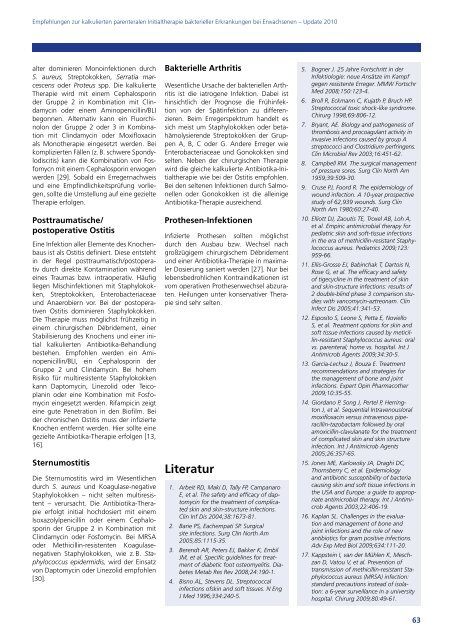


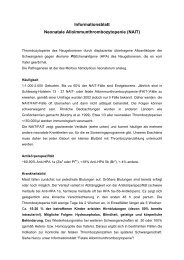
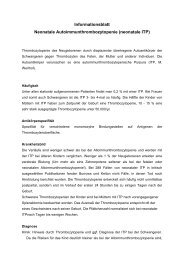
![Ausgabe Januar 2013 [pdf] - UKSH Universitätsklinikum Schleswig ...](https://img.yumpu.com/11131115/1/184x260/ausgabe-januar-2013-pdf-uksh-universitatsklinikum-schleswig-.jpg?quality=85)
![Qualitätsbericht 2011 Campus Kiel [PDF] - UKSH ...](https://img.yumpu.com/9884717/1/184x260/qualitatsbericht-2011-campus-kiel-pdf-uksh-.jpg?quality=85)

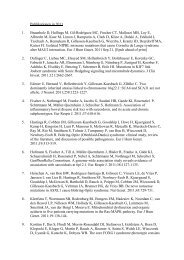
![Interdisziplinäres Symposium Inkontinenz am 24.9.08 [pdf] - UKSH ...](https://img.yumpu.com/7718861/1/190x135/interdisziplinares-symposium-inkontinenz-am-24908-pdf-uksh-.jpg?quality=85)
